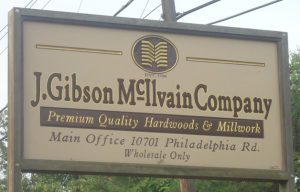We may receive a commission when you use our affiliate links. However, this does not impact our recommendations.
 On my way home from a visit with the Triangle Woodworker’s Association in Raleigh, N.C., I decided to drop in on the J. Gibson McIlvain Company of White Marsh, Md., (the chance to stop at a lumberyard that can trace its roots back to 1740 was far too tempting).
On my way home from a visit with the Triangle Woodworker’s Association in Raleigh, N.C., I decided to drop in on the J. Gibson McIlvain Company of White Marsh, Md., (the chance to stop at a lumberyard that can trace its roots back to 1740 was far too tempting).
If you think a company with a pre-Revolutionary history has a lumberyard filled with pit-sawn material that is moved about on horse-drawn carts, you’re terribly mistaken. The state of lumber processing is decidedly modern at McIlvain. The 1960 facility has no logs or sawmills on the property but they do handle vast quantities of domestic and exotic hardwoods. Strictly a wholesale business, this is not the place for most woodworkers who only need a few board feet of material for their current project. These guys handle massive quantities of wood and are one of the largest importers of teak in North America.

Moving large quantities of material that is highly monitored and regulated by the federal government means McIlvain needs some seriously high-tech ways of tracking their material from sawmill to end user. One of the coolest machines I saw during my visit employs two cameras and is called Vision Tally.
The cameras are computer controlled and work in tandem. The material is offloaded from the delivery trucks and placed on a conveyor that moves the bundles of material to a scanning area. The operator inputs all the vital information about the bundle including the tracking number put on the lot at the sawmill. Digital pictures are then taken of the boards in each lumber pack. These pictures create an electronic image of each board in the pack. While that may not sound exciting, it’s a definite upgrade in efficiency and accuracy. The Vision Tally accurately counts every board foot of lumber in a pack. It also produces a list showing each and every board’s thickness, width and length; it even accounts for wane.
McIlvain gathers a fair amount of information from this process which is fed directly into the company’s inventory program. Prior to the Vision Tally, every pack had to be opened and tallied by hand. This meant less accuracy on the board-footage count as well as higher end-user costs because of the added labor. It also meant more chance of the lumber from different packs getting mixed together. For McIlvain, using Vision Tally means more efficiently tracking their inventory, less waste and less frustration for their customers. It also means they are more compliant with lumber regulations because they can accurately track material from the forest to the end user (or at least the retailer to whom they sell the material).

Later that same week I visited one of my regular lumber suppliers (Fleetwood Lumber and Flooring), who happens to sell hardwood flooring (much of their rough flooring material comes from McIlvain). When the material is delivered, McIlvain gives them a copy of the report created by the cameras. For Fleetwood, the report means they can tell their customer (usually a hardwood-flooring installation contractor) a great deal about their flooring including how much waste there will be. In the end the modern equipment helps more than McIlvain maximize their efforts, it helps the end user waste less lumber.
Here are some supplies and tools we find essential in our everyday work around the shop. We may receive a commission from sales referred by our links; however, we have carefully selected these products for their usefulness and quality.







Nice article Chuck. Come back soon, I have a bunch of Mahogany with your name on it 😉 Actually I still consider McIlvain to be pretty low tech in what we do. Because we handle so many species and types of products from ply to softwood to millwork it is hard to find one system that can automate it all. At the same time our customers have such specific needs that you just can substitute a machine for hand grading and quality control. However you will have to pry our vision tally from our cold, dead hands. Sometime if you have the opportunity go visit one of the massive softwood mills or a plywood manufacturer. That is a modern marvel the size of a city!
Thanks for this wonderful information. My, my how thecnology has changed our way of life for the better. I’m a staunch beliver in accurate inventory control of all comodities, and never would have thought of such a great capability existed in the lumber industry.